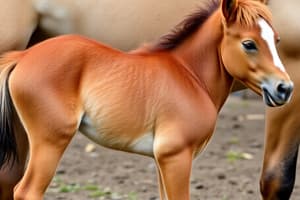Podcast
Questions and Answers
A 12-year-old gelding presents with lethargy, a rectal temperature of 102.3°F, heart rate of 44 bpm, respiratory rate of 24 bpm, tracheal rattle, and increased bronchovesicular sounds. Which hematological abnormality from the provided bloodwork is MOST indicative of an acute inflammatory response in this horse?
A 12-year-old gelding presents with lethargy, a rectal temperature of 102.3°F, heart rate of 44 bpm, respiratory rate of 24 bpm, tracheal rattle, and increased bronchovesicular sounds. Which hematological abnormality from the provided bloodwork is MOST indicative of an acute inflammatory response in this horse?
- Platelet count of 93 K/uL (Reference Range: 100-600 K/uL)
- Lymphocyte concentration of 1.2 K/uL (Reference Range: 1.5-7.7 K/uL)
- Fibrinogen of 700 mg/dL (Reference Range: 100-400 mg/dL)
- Segmented neutrophil concentration of 21.1 K/uL (Reference Range: 2.5-7.5 K/uL) (correct)
Considering the clinical signs and initial bloodwork of the 12-year-old gelding, which diagnostic procedure would provide the MOST direct and informative sample for confirming a bacterial pneumonia and guiding antimicrobial therapy?
Considering the clinical signs and initial bloodwork of the 12-year-old gelding, which diagnostic procedure would provide the MOST direct and informative sample for confirming a bacterial pneumonia and guiding antimicrobial therapy?
- Thoracic radiography to assess for alveolar infiltrates.
- Transtracheal wash for cytology and bacterial culture. (correct)
- Arterial blood gas analysis to evaluate oxygenation status.
- Fecal examination for parasite load to rule out verminous pneumonia.
A 7-year-old Quarter Horse mare presents with weight loss and dysphagia. Physical examination reveals a firm, stationary, palpable mass with associated edema under the right mandible. Endoscopic examination reveals a pharyngeal mass causing compression. Based on these findings, what is the MOST likely primary problem?
A 7-year-old Quarter Horse mare presents with weight loss and dysphagia. Physical examination reveals a firm, stationary, palpable mass with associated edema under the right mandible. Endoscopic examination reveals a pharyngeal mass causing compression. Based on these findings, what is the MOST likely primary problem?
- Temporohyoid osteoarthropathy affecting the temporomandibular joint.
- Esophageal obstruction due to a feed impaction.
- Dental malocclusion with secondary masticatory muscle myositis.
- Pharyngeal abscess associated with Streptococcus equi infection. (correct)
In the case of the mare with suspected strangles and a pharyngeal abscess, the veterinarian opts to manage her conservatively without initial antibiotic administration. What is the PRIMARY rationale for this management approach in uncomplicated strangles cases?
In the case of the mare with suspected strangles and a pharyngeal abscess, the veterinarian opts to manage her conservatively without initial antibiotic administration. What is the PRIMARY rationale for this management approach in uncomplicated strangles cases?
A 5-month-old Thoroughbred filly presents with a history of nasal discharge unresponsive to clenbuterol. Physical exam is unremarkable except for moderate nasal discharge. Hematology reveals a mild leukocytosis. Considering the age and clinical signs, which of the following is the MOST likely differential diagnosis?
A 5-month-old Thoroughbred filly presents with a history of nasal discharge unresponsive to clenbuterol. Physical exam is unremarkable except for moderate nasal discharge. Hematology reveals a mild leukocytosis. Considering the age and clinical signs, which of the following is the MOST likely differential diagnosis?
For the 5-month-old filly with nasal discharge, nasal swabs are submitted for viral and bacterial PCR. What is the PRIMARY purpose of performing PCR testing in this case rather than relying solely on bacterial culture?
For the 5-month-old filly with nasal discharge, nasal swabs are submitted for viral and bacterial PCR. What is the PRIMARY purpose of performing PCR testing in this case rather than relying solely on bacterial culture?
A 6-year-old show horse presents with coughing, lethargy, and bilateral serous to mucoid nasal discharge. Temperature is 104.5°F, heart rate 60 bpm, respiratory rate 40 bpm. Tracheal palpation induces a cough. When questioning the owner, what is the MOST critical piece of historical information to ascertain regarding potential infectious respiratory disease?
A 6-year-old show horse presents with coughing, lethargy, and bilateral serous to mucoid nasal discharge. Temperature is 104.5°F, heart rate 60 bpm, respiratory rate 40 bpm. Tracheal palpation induces a cough. When questioning the owner, what is the MOST critical piece of historical information to ascertain regarding potential infectious respiratory disease?
In the 6-year-old show horse with fever and nasal discharge, a CBC and chemistry panel are performed, along with a nasal swab for PCR. What is the PRIMARY purpose of performing a CBC in this case, even if a viral respiratory infection is suspected?
In the 6-year-old show horse with fever and nasal discharge, a CBC and chemistry panel are performed, along with a nasal swab for PCR. What is the PRIMARY purpose of performing a CBC in this case, even if a viral respiratory infection is suspected?
An 18-year-old American Paint horse with a chronic cough worsening with exercise and mucoid nasal discharge exhibits increased bronchovesicular sounds and crackles on lung auscultation. Bronchoalveolar lavage (BAL) cytology reveals >95% non-degenerate neutrophils. These findings are MOST consistent with which respiratory condition?
An 18-year-old American Paint horse with a chronic cough worsening with exercise and mucoid nasal discharge exhibits increased bronchovesicular sounds and crackles on lung auscultation. Bronchoalveolar lavage (BAL) cytology reveals >95% non-degenerate neutrophils. These findings are MOST consistent with which respiratory condition?
For the 18-year-old horse diagnosed with Severe Equine Asthma (SEA), systemic corticosteroids are recommended as part of the management plan. What is the PRIMARY mechanism by which corticosteroids improve respiratory function in horses with SEA?
For the 18-year-old horse diagnosed with Severe Equine Asthma (SEA), systemic corticosteroids are recommended as part of the management plan. What is the PRIMARY mechanism by which corticosteroids improve respiratory function in horses with SEA?
A 90-day-old Thoroughbred foal presents with lethargy, increased respiratory rate, crackles in cranioventral lung fields, tracheal rattle, and fever (103.5°F). Thoracic ultrasound reveals peripheral hypoechoic areas. Based on these findings and the foal's age, what is the MOST likely top differential diagnosis?
A 90-day-old Thoroughbred foal presents with lethargy, increased respiratory rate, crackles in cranioventral lung fields, tracheal rattle, and fever (103.5°F). Thoracic ultrasound reveals peripheral hypoechoic areas. Based on these findings and the foal's age, what is the MOST likely top differential diagnosis?
In a 90-day-old foal diagnosed with Rhodococcus equi pneumonia, initial treatment with TMS-SMZ and gentamicin is ineffective. What is the MOST appropriate next step in antimicrobial therapy?
In a 90-day-old foal diagnosed with Rhodococcus equi pneumonia, initial treatment with TMS-SMZ and gentamicin is ineffective. What is the MOST appropriate next step in antimicrobial therapy?
A client with 15 pleasure performance horses inquires about strangles vaccination. What is the MOST important initial step you should recommend to determine if strangles vaccination is appropriate for her herd?
A client with 15 pleasure performance horses inquires about strangles vaccination. What is the MOST important initial step you should recommend to determine if strangles vaccination is appropriate for her herd?
If serum antibody titers for Streptococcus equi M protein are low (<1:3,200) in the pleasure performance horses and the risk of exposure is considered moderate to high, which type of strangles vaccine is GENERALLY considered the SAFEST and MOST effective for routine use in these horses?
If serum antibody titers for Streptococcus equi M protein are low (<1:3,200) in the pleasure performance horses and the risk of exposure is considered moderate to high, which type of strangles vaccine is GENERALLY considered the SAFEST and MOST effective for routine use in these horses?
Following the diagnosis of strangles in a horse on a pasture, what is the MINIMUM recommended pasture rest period after the infected horse with a draining abscess is removed, to minimize environmental contamination with Streptococcus equi?
Following the diagnosis of strangles in a horse on a pasture, what is the MINIMUM recommended pasture rest period after the infected horse with a draining abscess is removed, to minimize environmental contamination with Streptococcus equi?
Describe the MOST accurate pathway of Streptococcus equi infection leading to guttural pouch empyema.
Describe the MOST accurate pathway of Streptococcus equi infection leading to guttural pouch empyema.
In horses with guttural pouch empyema secondary to strangles, chondroids (inspissated pus concretions) can form. What is the MOST significant clinical implication of guttural pouch chondroids?
In horses with guttural pouch empyema secondary to strangles, chondroids (inspissated pus concretions) can form. What is the MOST significant clinical implication of guttural pouch chondroids?
A horse with a history of equine asthma is undergoing bronchoalveolar lavage (BAL). A high percentage of non-degenerate neutrophils is observed in the BAL fluid. Which cellular mechanism is MOST directly responsible for the presence of non-degenerate neutrophils in the airways of asthmatic horses?
A horse with a history of equine asthma is undergoing bronchoalveolar lavage (BAL). A high percentage of non-degenerate neutrophils is observed in the BAL fluid. Which cellular mechanism is MOST directly responsible for the presence of non-degenerate neutrophils in the airways of asthmatic horses?
In equine asthma management, bronchodilators are often used in conjunction with corticosteroids. What is the PRIMARY mechanism of action of bronchodilators like clenbuterol in improving respiratory function?
In equine asthma management, bronchodilators are often used in conjunction with corticosteroids. What is the PRIMARY mechanism of action of bronchodilators like clenbuterol in improving respiratory function?
A horse is diagnosed with pleuropneumonia ('shipping fever'). Which of the following clinical signs is MOST suggestive of pleural effusion, a common complication of pleuropneumonia, rather than simple pneumonia?
A horse is diagnosed with pleuropneumonia ('shipping fever'). Which of the following clinical signs is MOST suggestive of pleural effusion, a common complication of pleuropneumonia, rather than simple pneumonia?
When performing thoracocentesis to drain pleural fluid in a horse with pleuropneumonia, what is the MOST important anatomical landmark to avoid puncturing during the procedure?
When performing thoracocentesis to drain pleural fluid in a horse with pleuropneumonia, what is the MOST important anatomical landmark to avoid puncturing during the procedure?
In managing a horse with pleuropneumonia, broad-spectrum antibiotics are essential. Which of the following antibiotic combinations provides the MOST comprehensive coverage for the common bacterial pathogens involved in equine pleuropneumonia?
In managing a horse with pleuropneumonia, broad-spectrum antibiotics are essential. Which of the following antibiotic combinations provides the MOST comprehensive coverage for the common bacterial pathogens involved in equine pleuropneumonia?
For a horse recovering from pleuropneumonia, what is the MOST important long-term management strategy to minimize the risk of recurrence and optimize lung function?
For a horse recovering from pleuropneumonia, what is the MOST important long-term management strategy to minimize the risk of recurrence and optimize lung function?
Equine Viral Rhinopneumonitis (EHV-1 and EHV-4) is a common cause of respiratory disease in horses. Which clinical sign is MORE typically associated with EHV-1 infection compared to EHV-4 infection?
Equine Viral Rhinopneumonitis (EHV-1 and EHV-4) is a common cause of respiratory disease in horses. Which clinical sign is MORE typically associated with EHV-1 infection compared to EHV-4 infection?
Vaccination against Equine Herpesvirus (EHV) is a core vaccine for horses. What is the PRIMARY goal of EHV vaccination in horses?
Vaccination against Equine Herpesvirus (EHV) is a core vaccine for horses. What is the PRIMARY goal of EHV vaccination in horses?
In a group of horses exposed to Equine Influenza Virus (EIV), which of the following management strategies is MOST effective in controlling the spread of the virus and minimizing the impact of an outbreak?
In a group of horses exposed to Equine Influenza Virus (EIV), which of the following management strategies is MOST effective in controlling the spread of the virus and minimizing the impact of an outbreak?
A horse presents with chronic, progressive weight loss despite a normal appetite, along with intermittent low-grade fever and a chronic cough. Thoracic radiographs reveal diffuse, nodular interstitial lung patterns. Which of the following is the MOST likely differential diagnosis?
A horse presents with chronic, progressive weight loss despite a normal appetite, along with intermittent low-grade fever and a chronic cough. Thoracic radiographs reveal diffuse, nodular interstitial lung patterns. Which of the following is the MOST likely differential diagnosis?
The pathogenesis of Equine Multinodular Pulmonary Fibrosis (EMPF) is thought to be associated with infection by which viral agent?
The pathogenesis of Equine Multinodular Pulmonary Fibrosis (EMPF) is thought to be associated with infection by which viral agent?
What is the PRIMARY diagnostic modality for confirming Equine Multinodular Pulmonary Fibrosis (EMPF) in a horse with compatible clinical signs and radiographic findings?
What is the PRIMARY diagnostic modality for confirming Equine Multinodular Pulmonary Fibrosis (EMPF) in a horse with compatible clinical signs and radiographic findings?
Flashcards
Pneumonia
Pneumonia
Inflammation of the lungs.
Transtracheal wash
Transtracheal wash
A procedure to collect a sterile sample from the trachea for culture.
Strep equi (Strangles)
Strep equi (Strangles)
An infectious disease caused by Streptococcus equi, leading to abscess formation.
Administer NSAIDs
Administer NSAIDs
Signup and view all the flashcards
Do not administer antibiotics
Do not administer antibiotics
Signup and view all the flashcards
Guttural Pouch Empyema
Guttural Pouch Empyema
Signup and view all the flashcards
R. equi
R. equi
Signup and view all the flashcards
Anhidrosis
Anhidrosis
Signup and view all the flashcards
Check titer
Check titer
Signup and view all the flashcards
How is Strep Equi spread?
How is Strep Equi spread?
Signup and view all the flashcards
Study Notes
Horse with Cough
- A 12-year-old gelding with a cough presents as quiet and lethargic.
- Moderate vital parameter abnormalities are noted, specifically, T=102.3 F, P=44 BPM, RR=24 BrPM.
- Auscultation reveals a tracheal rattle and increased bronchovesicular sounds.
- Pneumonia is suspected due to fever, abnormal pulmonary sounds, and inflammatory leukogram.
- Perform thoracic ultrasound to assess pulmonary abnormalities.
- A transtracheal wash is needed to collect sterile samples for culture.
- It is appropriate to start broad-spectrum antibiotic therapy.
- Consider Trimethoprim sulfamethoxazole at 20 mg/kg PO BID or Doxycycline at 10 mg/kg PO BID.
Horse Not Eating Properly
- A 7-year-old Quarter Horse mare presents with weight loss and grain refusal, which is considered unusual for this particular horse.
- A referring veterinarian had previously done dental floatation but found no major issues beyond a potential sharp point.
- The horse was then referred to K-State because there was no improvement over 10 days.
- The mare displays normal vital parameters, with a temperature of 100.1 F, a heart rate of 40 BPM, and a respiratory rate of 24 BPM, upon presentation.
- A firm, stationary palpable mass with edema is found under the right mandible on the ventral aspect.
- The mare eagerly tries to eat hay and grain but quids hay into balls.
- Primary problem is Strep equi (strangles) infection.
- Upper airway endoscopy shows pharyngeal compression.
- Guttural pouches are examined and samples taken for culture and PCR.
- Overall the horse appears stable.
- Management includes allowing the abscess to mature, break, and drain.
- NSAIDs for pain and airway inflammation are recommended.
- Antibiotics may slow disease progression and should be avoided.
- Complete recovery is possible within 2-3 months.
- Direct contact or fomites via inhalation or ingestion of Strep equi can cause guttural pouch empyema.
- The path of infection is via mucosal penetration and access to regional lymphatics
- A retropharyngeal lymph abscess ruptures into the guttural pouch
- Marked nasal discharge infects other horses and exudate entrapped in guttural pouch due to inflamed or malformed GP openings.
- Guttural pouch empyema and chondroids can also form.
- Submandibular lymph nodes do not rupture into the guttural pouch. Only retropharyngeal ruptures into guttural pouch.
- Rest a pasture after a strangles infected horse has been discovered with a draining abscess in the pasture for at least 1 week, if possible 30 days or longer
- Longer if winter weather
- Summer weather with sun and heat better for non-survival of bacteria
Filly with Nasal Discharge
- A 5-month-old Thoroughbred filly has a history of nasal discharge.
- The filly was treated with clenbuterol on a breeding farm.
- No improvement was seen after three weeks, with the filly developing a moderate nasal discharge.
- The filly is alert and responsive with a temperature of 101.7 F, a heart rate of 60 bpm, and a respiratory rate of 16 bpm.
- Hematology shows: Total leukocyte count of 14.2 x 103, Neutrophils of 10.7 x 103, Bands of 0, Lymphocyte count of 3.4 x 103, Fibrinogen of 400 mg / dL, HCT of 33%, Total protein of 6.3 g/dL and Platelets of 340 x 103
- This filly's problems include fever, nasal discharge, tachycardia, and mild leukocytosis.
- Differentials to consider are Viral respiratory disease (EIV > EHV-1 or 4), Bacterial respiratory disease (S. equi subsp. zooepidemicus or R. equi), and Parasitic respiratory (Parascaris equuorum).
- Diagnostic approach includes a nasal swab for viral/bacterial pathogens using PCR, fecal floatation, and thoracic ultrasound.
- If the thoracic ultrasound is abnormal, and there is pneumonia, a transtracheal wash for culture and sensitivity is recommended.
Show Horse Examination
- A six-year-old show horse is housed at an equine boarding facility.
- The mare is quiet and coughing.
- On examination, bilateral serous to mucoid nasal discharge is apparent.
- Her temperature is 104.5 F, heart rate is 60 BPM, and respiratory rate is 40 BrPM.
- Tracheal palpation induces coughing.
Approach to Respiratory Disease in Horses
- Pertinent questions to ask the owner include vaccine status and recent exposure to horse shows.
- Work up should include a CBC and Chemistry panel.
- Testing should include a nasal swab for viral and bacterial pathogens via PCR.
- In addition, consider a thoracic ultrasound to check for pulmonary changes.
- Initial treatment involves NSAID therapy for fever to encourage eating and drinking.
- If there is an inflammatory leukogram or mucoid to mucopurulent nasal discharge, antibiotics are indicated.
- A typically unremarkable CBC suggests a simple viral respiratory infection.
Paint Horse Coughing
- An 18-year-old American Paint horse coughs for three months, and it gets worse with exercise.
- Mucoid nasal discharge comes out of the Paint horse’s mouth during coughing.
- Symptoms have worsened in the prior month.
- Ceftiofur crystalline free acid (Excede) was administered a month earlier without improvement.
- On examination the horse is BAR, with T = 99.1 F, HR = 32 BPM, RR = 24 BrPM.
- There are increased bronchovesicular sounds throughout the lung fields with crackles in the left cranioventral lung field.
- Also present is a mild tracheal rattle.
- Tracheal palpation does not induce coughing.
- Suspect severe equine asthma, chronic cough for which antibiotics have provided insufficient time to work.
- Secondary bacterial infection is also possible.
- For clinical management, recommend systemically administered corticosteroids like dexamethasone at 0.05 mg/kg IV or IM daily.
- Also administer broad-spectrum antibiotic like TMS-SMZ, doxycycline, or ceftiofur (Naxcel) 2.2 mg/kg IM BID for 7 days.
- Prognosis is favorable for improvement but guarded for complete recovery.
- SEA (Severe Equine Asthma) is lifelong with intermittent flare-ups where environment and medications can be adjusted as needed.
Infectious Respiratory Disease in Foals
- A 90-day-old Thoroughbred foal, born on a breeding farm in central Kentucky, is lethargic and has an increased respiratory rate over the past week.
- Crackles are auscultated in the cranioventral lung fields, and tracheal compression elicits paroxysmal cough.
- An audible tracheal rattle and a fever of 103.5 F are noted.
- Thoracic ultrasound shows multiple peripheral hypoechoic areas measuring 2-6 cm bilaterally.
- Alveolar and nodular patterns are evident on thoracic radiography.
- The CBC reveals an inflammatory leukogram with hyperfibrinogenemia.
- A transtracheal wash is pending.
- The top differential for this foal is R. equi due to high risk of exposure on the breeding farm.
- Infection likely occurred on the breeding farm in Kentucky.
- Appropriate antibiotics include Azithromycin + rifampin or Clarithromycin + rifampin.
- Be aware of potential anhidrosis and diarrhea in the foal or mare.
Strangles Vaccination Plan
- Assess the client's vaccination plan for 15 pleasure performance horses and if they should vaccinate for strangles
- Check titer, if <1:3,200 and risk of exposure is high, then vaccine is recommended.
- Check titer on all horses being vaccinated.
Studying That Suits You
Use AI to generate personalized quizzes and flashcards to suit your learning preferences.




